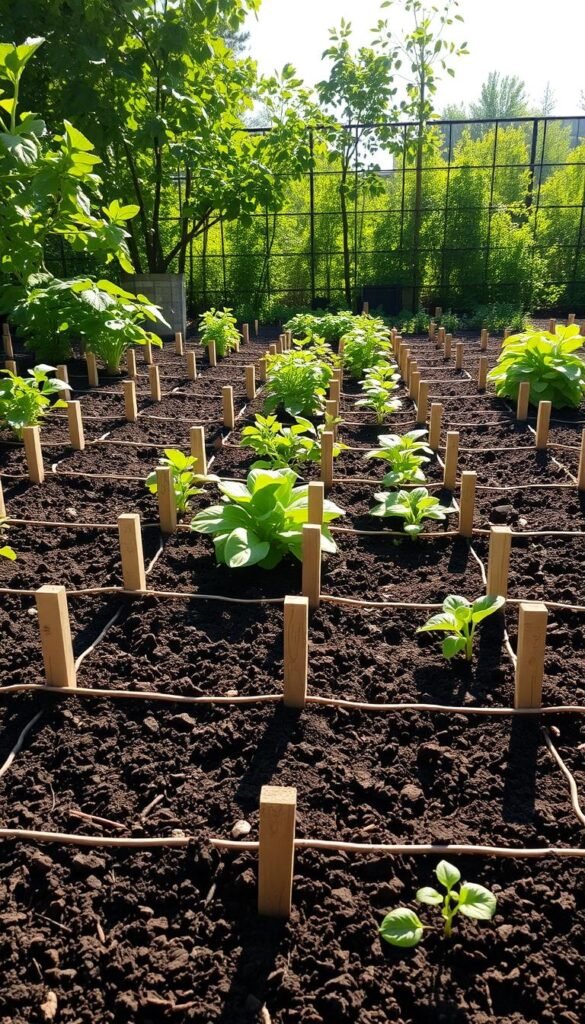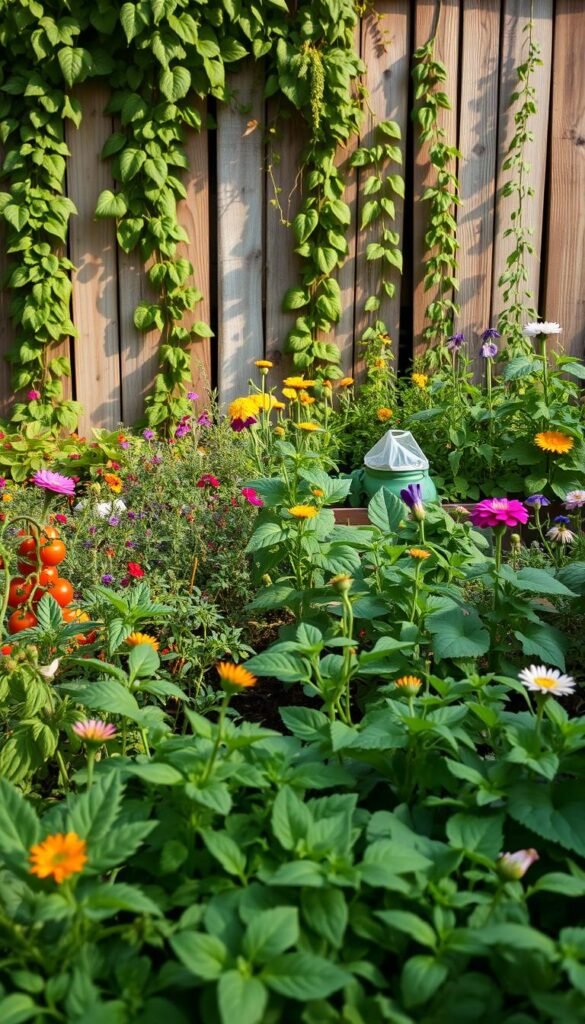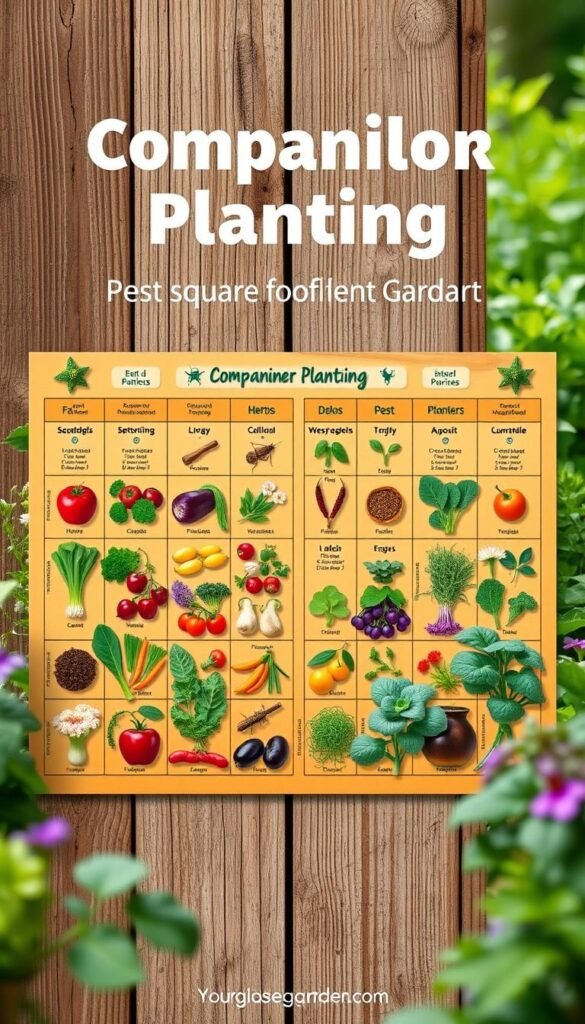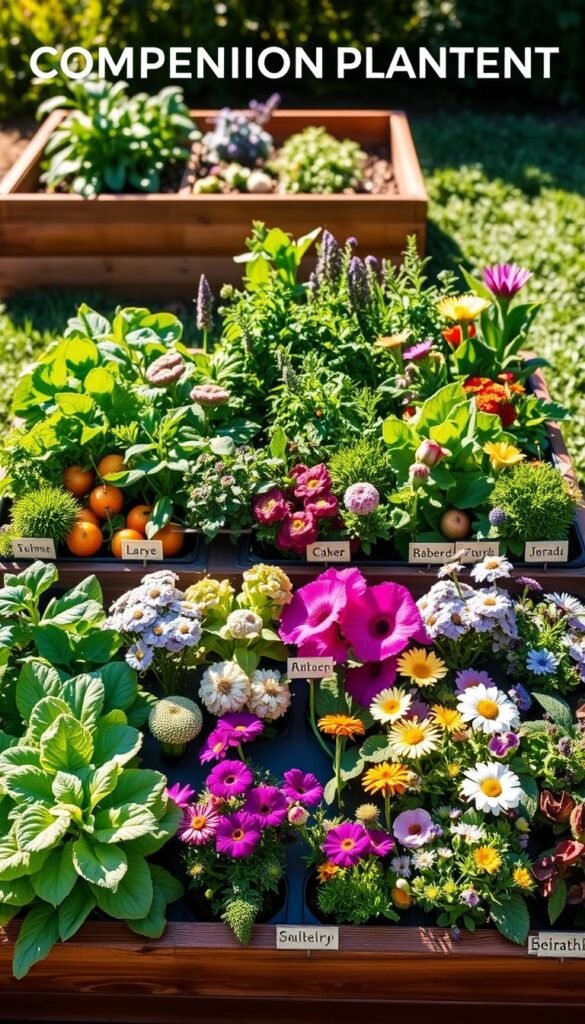Imagine growing a garden where every plant works together like a team. This method, often taught at places like Descanso Gardens, uses a grid system to organize seeds and maximize space. By dividing your bed into 12-inch squares, you can plan how many crops fit in each area—like 16 carrots or one tomato per square. Pairing the right plants boosts growth and keeps pests away naturally.
Why does this work? Some plants attract helpful bugs, while others add nutrients to the soil. For example, basil repels aphids near tomatoes, and marigolds deter rabbits. The classic “Three Sisters” trio—corn, beans, and squash—shows how teamwork pays off: corn supports beans, beans feed the soil, and squash shades weeds. Tools like companion planting charts simplify planning so you avoid guesswork.
Classrooms use this approach too! Students collaborate to design garden maps, learning how spacing and partnerships matter. Resources from Homestead and Chill or The Almanac Garden Planner offer science-backed tips for healthy harvests. Ready to try? Let’s dig into the details!
Key Takeaways
- Grid-based layouts help organize crops efficiently, with specific seed counts per square.
- Strategic pairings improve soil health and naturally reduce pest problems.
- Examples like basil with tomatoes or the “Three Sisters” method show practical benefits.
- Charts and planners simplify designing a balanced, productive garden.
- Group activities, like mapping a garden, teach teamwork and scientific principles.
Planning Your Square Foot Garden for Companion Planting
Designing a thriving garden starts with smart layout choices. Think of your raised bed as a puzzle where each piece supports the others. This approach combines space efficiency with natural partnerships that boost growth and deter pests.

Understanding Companion Planting Principles
Some species act like superhero teams. Basil releases oils that shield tomatoes from aphids, while nasturtiums lure hungry caterpillars away from beans. “Good neighbors share resources,” explains a USDA gardening guide. Root vegetables like carrots thrive beside leafy greens since they occupy different soil layers.
Setting Up Your Garden Grid and Measuring Space
Follow these steps to build your framework:
- Mark a 12”x12” area using string or wooden dividers
- Divide squares into smaller sections based on seed size (e.g., 16 carrots or 4 onions per square)
- Use planning cards to visualize pairings—like radishes with spinach for quick harvests
Classroom activities show why spacing matters. Students often sketch layouts with colored pencils, discovering how pole beans need vertical space while squash spreads horizontally. A beet demonstration proves crowded roots stay stunted—leave 3-4 inches between seeds!
Partner projects help match plants with compatible needs. Try grouping nitrogen-fixing peas with heavy feeders like corn. Tools like the Almanac Garden Planner simplify testing layouts before planting.
Companion Planting in Square Foot Gardens: The Perfect Pairings
See how classrooms and gardeners use teamwork strategies for healthier harvests. These tried-and-tested combinations solve common growing challenges while teaching valuable lessons.

Nature’s Dynamic Duos
Beans and corn form a power couple. Beans add nitrogen to the soil, while corn stalks become natural trellises. Add squash, and you’ve got the Three Sisters method—a living lesson in resource sharing.
Marigolds aren’t just pretty. Their strong scent confuses pests like aphids. Pair them with tomatoes, and you’ll see fewer bugs munching leaves. One school group reported 40% less damage after adding these orange guardians.
| Plant | Partner | Benefit |
|---|---|---|
| Basil | Peppers | Repels flies |
| Nasturtium | Cucumbers | Traps beetles |
| Dill | Cabbage | Attracts wasps |
Learning Through Garden Maps
Students at Denver Urban Gardens use color-coded cards to design layouts. “They debate spacing needs like tiny landscape architects,” says teacher Mara Lin. Groups compete to fit the most crops while keeping allies nearby.
Try this activity:
- Print plant icons on sticky notes
- Mark zones using grid paper
- Swap layouts and spot mismatches
A 4th-grade class fixed their “lonely broccoli” by adding onion neighbors. Their revised plan yielded twice as many vegetables! Charts make these connections visible—circle friendly pairs in red, foes in black.
Effective Plant Pairings and Pest Management Strategies
Growing a vibrant garden requires more than just soil and sunlight—it’s about creating partnerships. When you match species that support each other, you’ll see stronger growth and fewer pests. Let’s explore how to build these alliances while keeping your space healthy.

Choosing Beneficial Plant Combinations
Focus on partnerships that solve problems. Marigolds release a scent that repels aphids, making them ideal neighbors for tomatoes. Pole beans climb corn stalks naturally, saving space while feeding the soil with nitrogen.
Root vegetables like radishes grow fast, loosening dirt for slower crops like carrots. A Denver gardener shared: “My squash plants thrived after I added nasturtiums—they trapped beetles that usually attack the leaves.”
Integrating Companion Planting Charts and Layout Plans
Visual tools simplify planning. The Almanac Garden Planner lets you drag icons onto a grid, showing which pairs thrive. Color-code your chart: green for growth boosters, red for pest blockers.
Try this tip: Place basil near peppers to deter flies. Leave gaps between cabbage rows for dill, which attracts wasps that eat caterpillars. Charts turn guesswork into strategy.
Managing Pests and Promoting Beneficial Insects
Herbs and flowers do double duty. Lavender confuses moths, while sunflowers draw ladybugs. One study found gardens with yarrow had 35% fewer aphids—no sprays needed!
Create insect hotels by leaving dead stems or stacking wood. French marigolds near tomatoes reduce root-knot nematodes. Observe which pairings work best, then adjust your plan each season.
Conclusion
Transforming your garden into a thriving ecosystem starts with smart partnerships. By pairing herbs, vegetables, and flowers strategically, you’ll boost growth naturally while keeping pests at bay. Remember how basil shields tomatoes or marigolds confuse hungry bugs? These alliances work like nature’s own security system.
Start by mapping your space using a simple grid—Descanso Gardens teachers swear by this method. Measure squares, group compatible plants, and leave room for roots to spread. Tools like The Almanac Garden Planner turn complex layouts into colorful puzzles anyone can solve.
Real-world results don’t lie. Students doubled harvests by fixing spacing issues, while home growers saw fewer beetles after adding nasturtiums. Your secret weapon? A free companion planting chart that shows which seeds thrive side-by-side. Download one, sketch your plan, and watch your square foot garden flourish.
Ready to grow more with less effort? Grab your grid paper and create a vibrant, chemical-free oasis where every plant has a purpose. Your future harvest—and the bees—will thank you!






